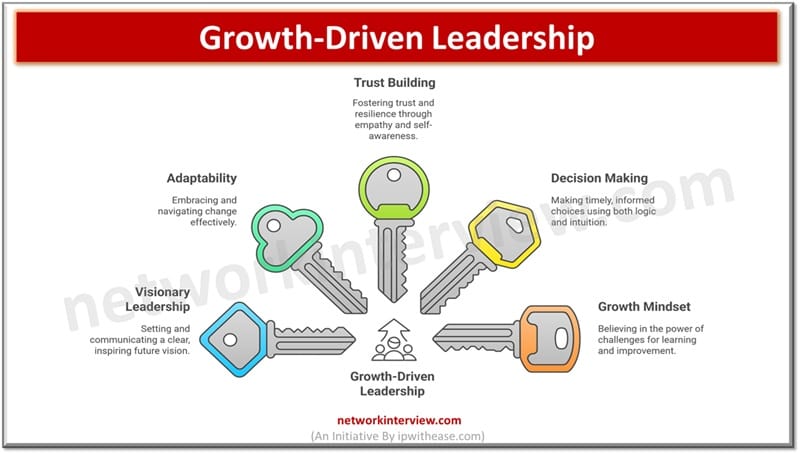
Growth-Driven Leadership: Navigating Change with Confidence
Because businesses change so quickly today, leaders are presented with unique obstacles. Since globalization, technology changes, changing customer expectations, and economic swings exist, leaders need to look past old management tactics. An approach based on agility and vision helps organizations use change and transition to build a stronger future. This blog discusses how Growth-Driven Leadership helps to face changes with confidence, the important personal traits a leader should work on, and why ongoing training helps them.
Introduction: Embracing Change with Purpose
Knowing how things are done and looking ahead is not enough. It demands emotional intelligence, adaptability, and proactiveness. Many companies worldwide are interested in finding leaders who can face uncertainty and promote extended growth.
To adapt for this challenge, professionals are joining top learning courses like IIM Calcutta Executive Program which give them thorough learning, a global approach and practical experience. Growth-driven leaders realize that before managing change, they should learn about themselves and give their teams focus and certainty.
What is Growth-Driven Leadership?
Leading in this way means emphasizing learning, being innovative, and acting before problems arise. Its purpose is to help create value, foster teamwork, and allow teams to perform well in complicated conditions. This kind of leadership is about thoughtful and fast responses to any kind of change.
Key Traits of Growth-Driven Leaders
- These leaders set a firm, exciting vision for the future and help everyone understand it so that they can work well together.
- Growth-driven leaders can still work effectively by changing rather than opposing changes that happen in the business world.
- Building trust and a resilient team requires leaders who are empathetic, aware of themselves, and skilled at dealing with people.
- Decision Making: They make good, timely choices by combining facts with their instincts.
- If you have a Growth Mindset, you believe that challenges can help you learn and improve.
Related: Enterprise Architect vs Technical Architect
Navigating Change with Confidence

All experiences are going to change. Managing and making use of changes is what distinguishes successful organizations. Transforming healthcare is largely dependent on leaders. This is how growth-driven leaders deal with change with confidence:
- Keep Your Ear to the Ground: They monitor advancements, shifts worldwide and new technologies, so they can steer strategy before being affected.
- Include key players: Honesty and cooperation with internal and external stakeholders help ensure unity and support for each stage of the transition.
- Support Innovation: They guarantee safety during the experimentation process so that teams can find creative alternatives.
- Invest in Resilience: Growth-focused leaders put in time to support their teams and strengthen each person’s mental and emotional abilities to change.
- Regular reviews and exchanges of feedback help businesses adjust course and solve problems right away.
Real-World Examples
- Satya Nadella’s leadership changes at Microsoft were centered on growth, cloud computing, and a culture that values diversity, helping to drive the company into new possibilities.
- Kiran Mazumdar-Shaw at Biocon is admired for her skills in growing and diversifying the business while facing new rules and global rivals.
The Role of Continuous Learning
Today, leaders must prioritize learning throughout their lives. Because technologies and business strategies are constantly growing and changing, what we learn today might not matter tomorrow. Leaders need to look for new ideas, tools, and abilities.
Executive education, thoughts shared by respected people, and learning with others can present useful information and help you grow professionally. Advanced programs available at institutions tackle present leadership problems by using the newest and most practical tools.
Challenges to Growth-Driven Leadership
- Growth-driven leadership is not always free from difficulties.
- Old habits can prevent organizations from transforming easily.
- Too much pressure to grow can result in people becoming tired mentally and physically.
- It is usually very difficult to keep the company’s long-term ambitions aligned with the outcomes reported quarterly.
A good way for leaders to tackle these obstacles is to focus on self-care, have strong support, and stay focused on what matters emotionally rather than on instant outcomes.
Strategies for Cultivating Growth-Driven Leadership
- Regularly think about your strong points, areas of weakness, and places you can improve.
- Look for and follow the advice of those who have accomplished what you are aiming for.
- Try out creative ideas, as they could force you to do things differently and challenge your usual approach.
- Give control to teams and allow them to run their projects.
- Ensure that every individual, team, and company goal is closely connected.
Conclusion: Leading with Courage and Commitment
Because disruptions in global markets occur more regularly, leadership is being examined more carefully. With growth-driven leadership, managers can handle these changes with ease, certainty, and significance. It’s not only about guiding the ship, you must also support and guide the group, change the direction at times, and stay steady through every bad weather condition.
An executive program or similar courses are designed to prepare leaders with the necessary mindset, tools, and strategies to perform well in changing and complex settings. Whether your organization is huge or just getting off the ground, making growth the main focus of leadership may be what helps you succeed in the future.
Tag:career



